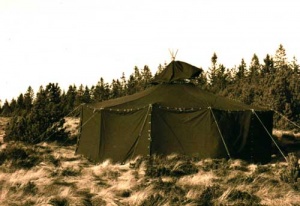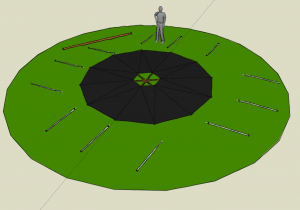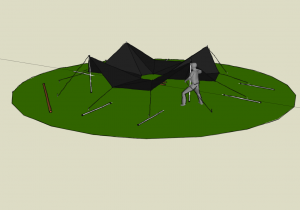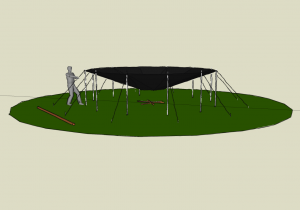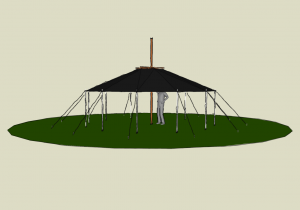Wie baue ich eine Jurte auf?/en: Unterschied zwischen den Versionen
Ralph (Diskussion | Beiträge) |
Ralph (Diskussion | Beiträge) |
||
| Zeile 87: | Zeile 87: | ||
=== Video about pitching up the yurt === | === Video about pitching up the yurt === | ||
[[Datei:videojurteaubau.jpg|thumb| | [[Datei:videojurteaubau.jpg|thumb|Pitching up the yurt - on Youtube - http://youtu.be/cS_SNYd1Lck]] Our video on Youtube shows you the basic steps. Thus you can see very clearly how one reaches into the other and how you best approach the structure of your yurt. | ||
[[Kategorie:Anleitungen]] | [[Kategorie:Anleitungen]] | ||
Aktuelle Version vom 12. April 2017, 14:27 Uhr
This manual describes the setting of a yurt. For pitching we use a single centre pole. Even though this manual basically describes the steps to pitch a TORTUGA yurt the steps to pitch TROLL or RAINBOW are roughly the same. In particular we here describe the setting of a standard yurt with a diameter of 6m and a sidewall height of 1,65m. Higher yurts or the supersize yurt can be set up, too, following this manual analogously.
Was benötigst du, um eine Jurte aufzustellen?
Es gibt sicher viele Wege eine Jurte aufzustellen und entsprechend unterscheidet sich auch das verwendete Material. Die folgenden Stücklisten geben einen Überblick, was du benötigst, um auch als Einsteiger einfach und sicher eine Jurte aufstellen zu können. Nicht genannt ist das Werkzeug, wie Hammer (für die Heringe) oder Säge (für die Jurtenstangen) oder ein Messer (um evtl. Seile anzupassen).
Jurte
- 1 Jurtendach, 600 cm, mit oder ohne Traufkante
- 6 Doppelzeltbahnen 323 x 165 cm (oder 12 Viereckzeltbahnen)
- 1 Jurten-Abdeckplane mit Rundleine
- 1 Jurtenkreuz oder Jurtenspinne, 6-fach
- 2 Mittelstangen ca. 420 cm
- 12 Aufstellstäbe min 165 cm
- 12 Heringe
- 12 Abspannseile, min 300 cm
- 12 Erdnägel
- 1 Blockseilrolle
- 1 Kunsthanfseil, ca. 300 cm
- 1 Kunsthanfseil, ca. 600 cm
- etwas Bindeschnur
Super-Jurte
- 1 Jurtendach, 600 cm, mit oder ohne Traufkante
- 6 Super-Doppelzeltbahnen 323 x 209 cm (oder 12 Super-Viereckplanen)
- 1 Jurten-Abdeckplane mit Rundleine
- 1 Jurtenkreuz oder Jurtenspinne, 6-fach
- 2 Mittelstangen ca. 510 cm
- 12 Aufstellstäbe min 209 cm
- 12 Heringe
- 12 Abspannseile, min 450 cm
- 12 Erdnägel
- 1 Blockseilrolle
- 1 Kunsthanfseil, ca. 300 cm
- 1 Kunsthanfseil, ca. 900 cm
- etwas Bindeschnur
Großjurte
- 1 Großjurtendach, 800 cm, mit Traufkante
- 8 Doppelzeltbahnen 323 x 165 cm (oder 16 Viereckzeltbahnen)
- 1 Jurten-Abdeckplane mit Rundleine
- 1 Jurtenkreuz oder Jurtenspinne, 8-fach
- 2 Mittelstangen ca. 510 cm
- 16 Aufstellstäbe min 165 cm
- 16 Heringe
- 16 Abspannseile, min 300 cm
- 16 Erdnägel
- 1 Blockseilrolle
- 1 Kunsthanfseil, ca. 300 cm
- 1 Kunsthanfseil, ca. 900 cm
- etwas Bindeschnur
Super-Großjurte
- 1 Großjurtendach, 800 cm, mit Traufkante
- 8 Super-Doppelzeltbahnen 323 x 209 cm (oder 16 Super-Viereckplanen)
- 1 Jurten-Abdeckplane mit Rundleine
- 1 Jurtenkreuz oder Jurtenspinne, 8-fach
- 2 Mittelstangen ca. 510 cm
- 16 Aufstellstäbe min 209 cm
- 16 Heringe
- 16 Abspannseile, min 450 cm
- 16 Erdnägel
- 1 Blockseilrolle
- 1 Kunsthanfseil, ca. 300 cm
- 1 Kunsthanfseil, ca. 900 cm
- etwas Bindeschnur
Giga-Großjurte
- 1 Giga-Jurtendach, 920 cm, mit Traufkante
- 9 Super-Doppelzeltbahnen 323 x 209 cm (oder 18 Super-Viereckplanen)
- 1 Jurten-Abdeckplane mit Rundleine
- 1 Jurtenkreuz oder Jurtenspinne, 9-fach
- 2 Mittelstangen ca. 510 cm
- 18 Aufstellstäbe min 209 cm
- 18 Heringe
- 18 Abspannseile, min 450 cm
- 18 Erdnägel
- 1 Blockseilrolle
- 1 Kunsthanfseil, ca. 300 cm
- 1 Kunsthanfseil, ca. 900 cm
- etwas Bindeschnur
How to pitching a yurt?
Lay out the roof
Lay the roof tarp outside up, exactly where you want have the yurt pitched (Half tarps or kota panels need to be lashed beforehand). The more accurate you lay out, the more stabile the yurt will stand later. The tarp should now show a regular dodecagon (hexadecagon for the supersize yurt).
When you look at the roof tarp you see a seam running from every corner towards the smoke hole. The imaginary extension of this seam shows you where the stakes and the 550 cord will have to placed later.
Lay out the side poles
The length of the poles has of course to follow the height of the sidewall. To gain more flexibility the use of adjustable telescope poles (basher pole) is recommended. The usual height, using the double square tarps, is 1,65m. In conjunction with the window panels or the super square- or super double square-tarp you can reach a height up to approx. 2,05m.
Take the poles and place them tip to D-ring (roof with eaves) respectively eyelet (roof without eaves). Place the poles on the before mentioned imaginary extension of the seam line pointing towards the centre of the fire hole. The bottom end of the pole marks the spot where you place the tent pegs. For staking out in hard soil T-profile stakes are recommended in soft soil you can even use wooden stakes. The pegs should be driven into the ground at least two third of their length.
Attach the guy ropes
The usable length of the cord should be approximately one and a half times of the side pole length. Attach one end to the D-Ring (or eyelet) of the roof tarp and the other end to the tent peg. If you tighten and loose the line from stake side or from D-Ring side (where you set the taut line hitch) is up to your choice.
Set up the side poles
Next you can start setting up the side poles to bring the side of the roof tarp to the required height. Up to this point all steps could easily be done by one single person. With a bit of experience it’s still possible to carry on alone but it would be easier with some helping hands that help you keeping the poles up.
Start with any pole by putting the tip into the D-Ring and bringing it into a vertical position. If there is a second person helping, your partner should start simultaneously on the opposite pole.
The next two poles should be ones halfway between the already set up ones and so on. Carry on this way until all 12 (16) poles are set up. Once finished the roof is now hanging in the air with the middle section pointing to the ground looking like a funnel.
At this stage the whole construction is still shaky and wind prone (that’s why additional helping hands to stabilise the poles are recommended). As soon as all cords get tightened equably the construction will stand all alone.
Hanging in the chain
Clip the 6 (8) single beams of the yurt chain into the D-Rings of the smoke hole. With D-shackles you can clip into D-ring as well as into eyelets. If your roof tarp is lashed out of single Kota-tarp be sure to always connect two eyelets with one D-shackle.
Instead of using the chain you can also use a yurt cross with bolts. Just hang the D-rings into the bolts. Tie the long rope to the carabiner in the centre of the yurt chain. This will later serve for pulling up the roof.
Set up centre pole
First tie the pulley with the short rope close to top end of the pole. Thread the long rope through the pulley. Now bring top end of the pole from underneath the tarp through the smoke hole and get the pole into a vertical position (some helping hands are definitely recommended). Pulling the roof up a bit in between this process makes it easier getting the pole into a vertical position.
Once the pole stands even pull the roof to the top and tie the rope to the pole. If this doesn’t work properly or the tarp shows pleats or is even sagging you’d have to check the anchor points (tent pegs) and maybe readjust them to ensure that they’re really in one line with the seam line. Slightly loosening or tightening the ropes may also help.
Mounting the sidewall tarps
When you have a roof with eaves you just button the tarps from the inside to the button tab of the roof tarp. To connect the tarps to each other you have to connect each of both buttons into the opposite buttonhole. With the newer roof tarps the corner-eyelets of the tarps are secured with rubber bands.
Having a roof tarp without eaves these eyelets need to be hooked to the tips of the side poles. For this you have to remove each pole hook the tarp in and bring it back.
Of course you can button the tarps to the roof at the very beginning. This may ease the work for short people, especially since you won’t have to work with stretched out arms over your head.
Once all sidewall tarps are connected the yurt is as good as finished. Now you can take the chance to readjust the side poles (if necessary) to tighten the side tarps and to secure the tarps with tent pegs (which is half the battle on windy days).
How to get into the yurt
Either you leave one compete side tarp out which gains a “regular” entrance or you open just one of the vertical connections. This way you just have to swing one tarp open to get in or out. You can form a triangle shape entrance by tying the bottom corner with a cord to the tip of a side pole.
Do you need a roof cap for the smoke hole?
The yurt is a genuine fire tent and the smoke takes off the best through a wide open smoke hole. Vice versa some rain may easily drop into the tent (mostly onto the fire place). If this doesn‘t bother you the yurt is now finished.
How to mount the roof cap?
The roof cap consists of seven fields and has eight eyelets into which you can tie slim cords (we recommend cheap sisal cords). Having a yurt with a 6 m diameter the lenght of the cords should be approximately 4 - 5 m.
Once the cords are attached you can start pulling the cap to the rooftop. Climb up to theroof top, edge through the smoke hole and tie the cap around the cross lashing spot of the centre poles.
This really sounds like a roundabout way and there is indeed an easy way:
First you have to decide how huge or small the gap between cap and smoke hole should be. Do you want the cap to close the whole smoke hole (as leak proof as possible) or do want it slightly open to gain some ventilation?
The answer causes the decision where you are going to set the lashing point which is ideally the spot where you place the roof cap.
Easiest way to do this is when bring don the roof again. Standing on the ground the smoke hole around your shoulders you can easily tie the cap in.
Ensure that the cords are not tangled, otherwise you‘d have trouble trying reach them from the outside once the roof is pulled up again.
Finally you tie the cords to the anchor lines (taut line hitch) and tighen them. You may have to test which guy line is the right one. Usually it‘s every second cord but this may differ according to the fabric.
Pulling the cords to the side you can open the smoke anytime you want to let out the smoke and close it again later.
As with everything in the yurt building, the exercise makes the master and the joy of experimenting shows you the right way for you.
Video about pitching up the yurt
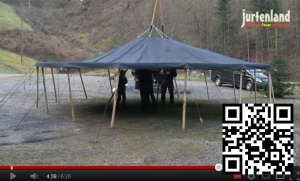
Our video on Youtube shows you the basic steps. Thus you can see very clearly how one reaches into the other and how you best approach the structure of your yurt.
